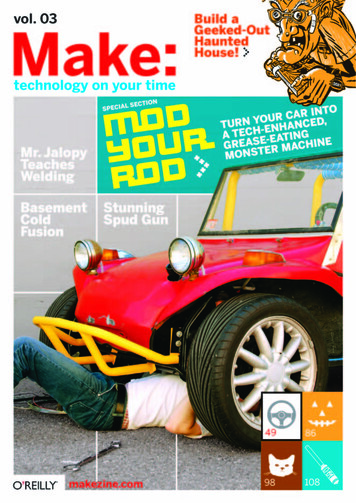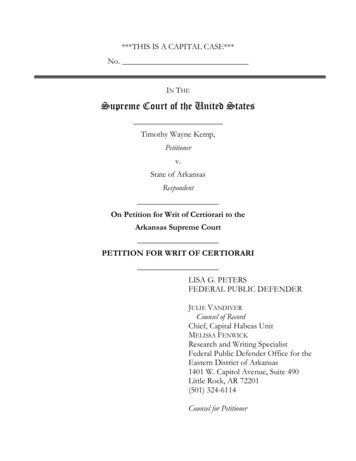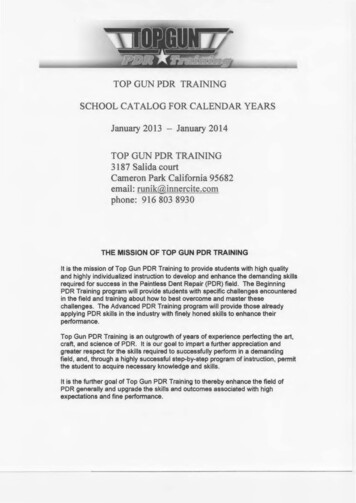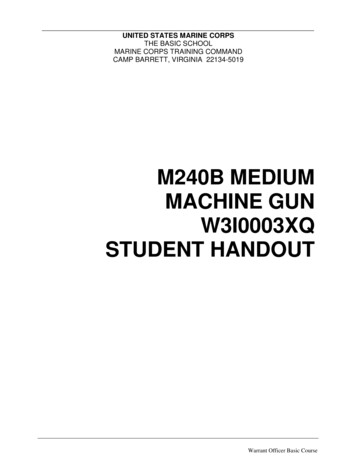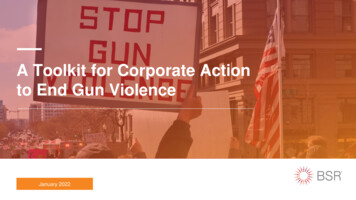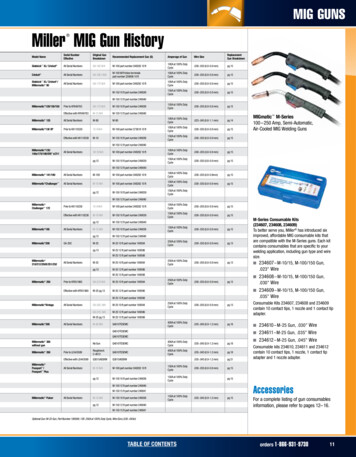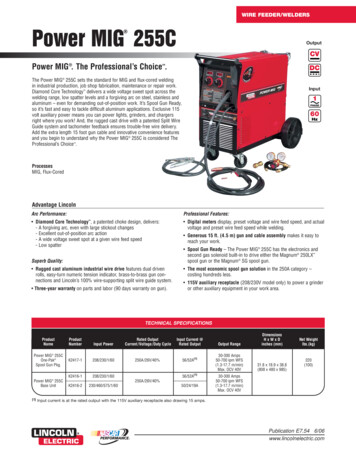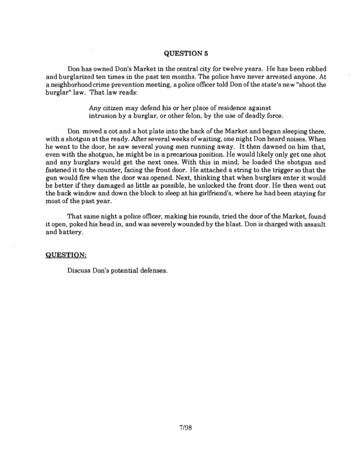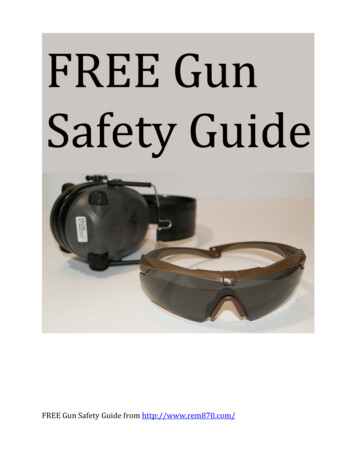
Transcription
FREE Gun Safety Guide from http://www.rem870.com/
FREE Gun Safety GuideBy Pedchenko Vitalyhttp://www.Rem870.comCopyright Pedchenko Vitaly 2013License NotesThank you for downloading this free ebook. You are welcome to share it with your friends.This book may be reproduced, copied and distributed for non-commercial purposes,provided the book remains in its complete original form. Thank you for your support.FREE Gun Safety Guide from http://www.rem870.com/
CONTENTSCHAPTER 1- Safely Storing Your Firearm At HomeCHAPTER 2 - Safely Transporting a FirearmCHAPTER 3 - Eye and Ear Protection When Using a FirearmCHAPTER 4 - Safety on the Firing RangeCHAPTER 5 - Teaching Children about Firearm SafetyCHAPTER 6 - Reloading Your Firearm SafelyCHAPTER 7 - Safely Carrying a Handgun for Personal ProtectionCHAPTER 8 - Shell Reloading SafetyCHAPTER 9 – Hunting SafetyCHAPTER 10 - Comprehensive Safety RulesAFTERWORDFREE Gun Safety Guide from http://www.rem870.com/
CHAPTER 1 - SAFELY STORING YOUR FIREARM AT HOMEOver 80 percent of home burglaries occur during daylighthours while the owners are away. This information isimportant to firearm owners. As a firearm owner, you wantto deny access to the firearm for your children's safety andto prevent theft of your weapon. However, you will alsoneed immediate access to the weapon when needed.Intruders know where the hiding places are so tucking thegun in a sock drawer simply will not work and it certainlywill not keep it out of the hands of children. Parents makethe mistake of believing their children do not know wherethe gun is hidden. Therefore, not only should the gun behidden but the gun safe or lockbox it is in should be hiddenas well.Some owners may believe that if they keep the gun lockedaway in a safe they would never get to it in time. Practicegoing to the safe or lock box and retrieving your weapon.Time yourself and you will realize that you will have thetime if you hear a noise. Additionally, by taking the time toretrieve your firearm you have time to think and evaluate thesituation, which can prevent an accident because that noiseyou heard may be your children or spouse. The few secondsit takes to get to your weapon allows time for you to determine the actual threat level.Trigger locks keep the weapon from being accidentally fired but will not prevent it from beingstolen. Keeping a weapon lying about during the day with a trigger lock on it means it will bestolen during a break in. Your safe or lock box must be such that it cannot be carried off. A standup gun safe that can accommodate rifles, shotguns and handguns is ideal. The safe can be placedin a closet to help conceal it or placed in the open. Many safes have a combination lock or even adigital lock on the outside and inner compartments that require keys. Ammunition should neverbe stored with the firearm, and firearms should never be left loaded whether they are locked upor not. Only load the weapon when you are ready to use it.Be careful about storing gun safes in damp areas like basements or garages unless it specificallystates it is waterproof. Corrosion can make ammunition misfire, which can create a dangeroussituation.You have to be aware that firearms are stolen by members of your own family often times. Therecent school tragedy was carried out by an individual that had stolen the weapons from hismother's home. Very young children can and have found loaded weapons in the home and haveaccidentally shot themselves and others but teenagers can also gain possession of the weapon tocommit suicide or to commit criminal acts with the weapon.FREE Gun Safety Guide from http://www.rem870.com/
Safely securing your weapon in your home not only protects you and your family but others inthe community as well. Firearm safety is not when you think of it. It must be practiced 100percent of the time.External Link: Gun SafesFREE Gun Safety Guide from http://www.rem870.com/
CHAPTER 2 - SAFELY TRANSPORTING A FIREARMThere are specific laws in each state that govern the transportation of a firearm. This articleassumes you have the right to carry a firearm and are of the required age. Many states requirethat a handgun (concealed weapon) be unloaded and in a locked container when in a vehicle. Alocked container is described as fully enclosed and locked by a key, padlock or combinationlock. The vehicle's trunk is considered a fully enclosed secure container. The glove compartmentis not considered a locked or secured container. There are exceptions, of course, a special permitcan be obtained in some cases, and there are exceptions for law enforcement personnel as well.This information should not be considered legal advice and it is incumbent upon everyone toknow and understand the laws in their state. If you have doubt as to whether you can carry aloaded weapon in a vehicle assume you cannot.Shotguns and rifles while not required to be in a locked container must be unloaded while beingtransported and there may be separate rules for weapons considered assault rifles. There are lawsthat dictate what is considered unloaded and loaded. Common sense tells you that if you have themagazine in the weapon but no round is chambered then the weapon is loaded. A shotgun with aslip on cartridge holder with shells attached to the weapon in some officer's mind may constitutea loaded weapon. Keep ammunition separate to avoid any misinterpretations of the law.Some states do allow police officers to verify if a firearm is unloaded if they pull you over on apublic highway or road. Ammunition magazines or loose ammunition lying in plain sight of theofficer will prompt them to ask if you have a firearm in the vehicle. Keep all firearm materialscontained and out of sight. Leaving rounds and magazines lying about anywhere is irresponsible.FREE Gun Safety Guide from http://www.rem870.com/
Some states ask that if you do not have a trunk and have secured the weapon in a lockedcontainer or have a shotgun or rifle laying in the back that you cover that container or firearm soit cannot be recognized by anyone looking inside. There should be zero evidence that you have aweapon in the vehicle. It is similar to leaving a purse or wallet in plain sight it is an invitation forsomeone to "smash and grab".An automobile accident can cause a firearm to discharge if loaded. Hunters have placed theirrifles in the back seat with the safety off and the weapon loaded. This is a dangerous situation ifthe hunter is involved in an accident. Even if there were not laws governing this, common senseshould tell you that if you do not have complete control of the firearm at all times then it shouldbe unloaded and secured.Some states require a Firearm Owner Identification Card (FIOD) to transport a firearm in avehicle. Rifles and shotguns in some states if encased and unloaded can be carried in a traditionalmounted gun rack in the back window, typically found in pickup trucks. Law enforcement inthese states will tell you that having firearms displayed is inviting theft.External link: Gun CasesFREE Gun Safety Guide from http://www.rem870.com/
CHAPTER 3 - EYE AND EAR PROTECTION WHEN USING A FIREARMAnyone that has fired a weapon has experienced ringing of the ears and stinging of the eyes.Repeatedly firing a weapon without ear protection will lead to permanent hearing loss. Semiautomatic weapons and bolt-action firearms discharge empty shells that pose a risk to your eyes,as well as, splatter and gunshot residue.Firearms can malfunction causing an explosion and of course, your face and eyes are in the lineof fire. Eye protection is critical; shooters have been blinded in one or both eyes because ofweapons that malfunction. Shooting at hard surfaces can cause the round to splatter or evenricochet. Splatter is small pieces of the projectile flying off in different directions as it strikes thehard surface. While the small pieces are not likely to penetrate clothing or cause serious damageto skin they can puncture the eyeball. Having eye and ear protection is required on any publicfiring range and most private ones.Earplugs are relatively inexpensive and foam ones can be purchased virtually anywhere.However, they are easily misplaced and most consider them disposable, or a onetime useearplug. There are plugs that are connected to a lanyard or line and can be draped around theneck when not in use. The plugs are usually soft plastic that can be used multiple times. Theseare easier to keep track of. Earmuffs by most accounts provide the most ear protection. They dodeaden all noise and if you are concerned about not hearing instructions from the range master,you can purchase electronic earmuffs.FREE Gun Safety Guide from http://www.rem870.com/
Electronic earmuffs allow normal sounds to be heard such as instructions from the rangemanager and other normal speech, but deaden the much louder noise of gunshots. If you cannothear the instructions from the range, you may tend to move your head and body for betterreception and this may cause you to sweep your weapon as you adjust position. Quality earprotection is necessary to make sure you can hear instructions from the range. Some shootershave custom-made earplugs. The ear is measured and plugs are made specifically for your ears.The plugs are much more comfortable than the generic one size fits all plugs. The plugs aredesigned to allow normal sounds to filter through while blocking loud noise.Your safety glasses should block objects from the side as well, and you can purchase glassesspecifically for shooting that provide this protection. You can get tinted ones for outdoor rangesor clear lenses for indoor ranges. The styles vary and most do not look like the old-fashionedsafety goggles.If you wear, corrective lenses and they are considered safety lenses the range master will likelyallow them. However, for your safety, make sure you know they are safety lenses or you canhave pair made that is. Non-safety lenses can shatter when struck. You can also buy safetyglasses designed to fit over your eyeglasses.Serious eye injuries have occurred because of flying brass. Tactical training requires shooters toshoot with their off hand or weak hand and right-handed shooters switching hands, especiallywith a rifle, knows that flying brass can be a serious issue.Investing in quality protection means you do not have to purchase protection every time you visitthe rage or target practice on your property, and make sure any one that is with you wears qualityprotection. Teach your children from now on the importance of eye and ear protection whenshooting.External Link: Eye and Ear ProtectionFREE Gun Safety Guide from http://www.rem870.com/
CHAPTER 4 - SAFETY ON THE FIRING RANGEFirearms do not shoot themselves; simply put they are amechanical device that requires certain actions beperformed before they can be fired. The person holdingthe weapon is what creates dangerous situations.Inexperience and simply not having your mind on thetask causes accidents at gun ranges.Typically, a firing range will have a safety office orsometimes called a range master assigned to ensure allrules are followed. Violations of the rules may meanyou are asked to leave and in some cases, not allowedback. The ranges can be open to the public or they canbe privately owned. Some private ranges such as onesassociated with a gun store may rent weapons out topeople or allow prospective buyers to test fire a weaponbefore purchasing. Firing ranges can be indoors oroutdoors. Generally, you must be between 18 and 21years of age and usually have to sign a waiver beforeyou are allowed to fire a weapon. Some ranges mayoffer firearm-training classes for a fee.THE RULESThis a basic outline of rules typically found at a gun range. Rules can vary depending on certainstate laws and the gun range itself. Rules such as caliber or type of weapon allowed on the rangewill vary from one range to another. First, obey all rules as established by the range master. Normally the rules are postedwhere you can read them before entering the range. When the order to cease-fire is given, youmust follow it. All weapons must be unloaded before entering the range facility, and unloaded prior todeparture. Some range masters may verify the weapons are unloaded. Ear plugs/ear protection is required on indoor and outdoor ranges as well as, eyeprotection. Flying brass poses serious risks to eyes. Public firing ranges usually will not allow fast draws, trick shooting or combat styleshooting. You can find ranges that cater to this type of shooting and they are normally privateranges. Weapons must be pointed downrange at all times whether it is loaded or not. If you arecaught, sweeping the weapon or swinging it in the direction of others you will be asked to leave.FREE Gun Safety Guide from http://www.rem870.com/
When not firing, the weapon must be unloaded and benched Typically, you are not allowed at the firing line nor can you have a weapon in your handswhen someone is downrange. This is a serious breach of the rules. You may be responsible for your own targets or can purchase ones there or themembership fee may cover the costs. Make sure you know what targets are authorized. Some ranges do not allow metal targetsbecause of splatter and ricochet. If metal ones are allowed, there may be a caliber restriction andusually the gun range will have a distance from the target requirement. Police up your brass and if you cannot find yours in particular pick up the number thatcorresponds to the amount fired and always pick up a few extra. Dispose of the brass in thedesignated containers or carry home for re-loading. If your weapon misfires, hold position for up to 20 seconds and then drop the magazineand remove the round or safely unload the revolver with the weapon always pointed downrange.If you cannot or simply do not know how ask for help from the range officer.Use common sense and always know what is going on around you. Remember the firing range isfull of people with loaded weapons.FREE Gun Safety Guide from http://www.rem870.com/
CHAPTER 5 - TEACHING CHILDREN ABOUT FIREARM SAFETYAccording to recent studies over 40 percent of all homes in the United States have, some type offirearm and one in four of those firearms is a handgun. Parents believe their children do notknow where the gun is hidden but statistics show that close to 80 percent of first and secondgraders that live in a home with a firearm knows where that firearm is.Parents are living under a misconception, which leads to accidents. Many think it is simplyenough to hide the firearm. Anyone that has children knows they are curious and if you try tosneak a gun past them into the home, they are going to want to know what it is. They will find itif it is not secured in a lockbox or gun safe. Parents have created a mystery that the childrensimply must solve, it is their nature.First, tell your children there is a firearm in the home. Then begin explaining what to do if theyever see that firearm or any other firearm. They are not to touch it, they are to leave the areaimmediately and must notify an adult. Tell them they must adhere to these rules in other homesas well. Your children may visit homes with firearms, so the rules apply no matter where theyare. There is nothing wrong with inquiring of your friends and neighbors about firearms in theirhomes if your children visit.Firearms are never to be loaded whenstored and do not store ammunitionwith the weapon. Do not leave thekeys to the lock box or gun safehanging with your car keys. Highrisks home are homes withadolescent boys and homes wherealcohol and drugs are used.Lack of supervision in the home willlead to gun related injuries andfatalities. Most accidental shootingsoccur during the summer monthswhen children may be out of school,and the hours after school whenchildren may be home alone. You simply cannot just hide a firearm in a drawer or high on acloset shelf and expect your children will not find it if they are home alone.Children that play with toy guns cannot distinguish between a real gun and a toy one. A childthat finds a real gun will naturally assume it is similar to the one they have been playing with.Children know to point and shoot because many play guns shoot darts or foam missiles. Theywill attempt to use the real firearm the same way. You must repeatedly explain the difference.FREE Gun Safety Guide from http://www.rem870.com/
Television, movies and video games may also show firearms being carried and used with noapparent injuries. Children can be influenced by what they see. You must explain that what theyare seeing is not real, and once again go over the real dangers of a firearm.Firearm safety starts with you. Children will follow your lead. If they see you acting careless andhandling, the firearm for no apparent reason they will want to as well. New gun owners tend towant to bring their handguns or rifles out to show them off or to handle them. Make sure you as aparent know and follow the rules. Lead your children by setting the example.The only time your weapon should be visible is when you are cleaning it or intend to use it forself-defense. Otherwise, it is unloaded and locked away securely in a lock box or safe.FREE Gun Safety Guide from http://www.rem870.com/
CHAPTER 6 - RELOADING YOUR FIREARM SAFELYAccidental discharges (AD) can happen when loading your weapon and they seem to be morecommon with rifles. One reason can be an extended primer on the cartridge that is struck by thebolt when you press the release. The primer can extend enough to where the bolt can cause theround to fire. Accidental discharge of pistols while loading can also be caused by a malfunctionof the pistol or inferior ammunition as well.The firing pin on some pistols is blocked fromrunning forward until the trigger is fully depressed.Some pistols allow you to lower the hammerwithout depressing the trigger, which can cause thefiring pin to release. On other models, you usuallywould depress the trigger and hold the hammer withyour thumb to drop the hammer slowly, and withyour other thumb in the way to keep it from strikingthe firing pin if your thumb slips. Of course, if youhave a round in the chamber and while "uncocking" your weapon the hammer slips, you havean AD.In the heat of competition shooting or if in a firefight, shooters may leave their finger on thetrigger while they reload. This of course is dangerous, and if caught doing it on a firing rangeyou may be asked to leave. The only time your finger is on the trigger is when you are preparedto shoot. You will not increase your shooting speed by having your finger "poised" on the triggeras you reload.If on a firing range, you must reload at the bench or firing line with the weapon pointeddownrange. If you have a revolver, swing the cylinder out and depress the plunger to push, thespent cartridges out or shake them loose. Either load each round by hand after verifying noobstructions in the chamber, or use a speed loader. If you have a semi-automatic drop the emptymagazine, verify no obstructions in the chamber, push the full magazine in, and set with the palmof your hand. Some at this point may chamber a round, pull the magazine out, and add one moreround. Obviously, you probably would not be able to do this in a firefight unless you have goodcover. Practicing moves and techniques you know you cannot use in a firefight can createproblems. Practice for is most likely to be the case during a tactical situation.Many experienced shooters and some members of the military adhere to the adage "never fire aweapon you did not load yourself". Your ammunition should have been inspected while loadingyour magazines or speed loaders or when filling your pouch. Bulging primers can cause an AD,as well as degraded or poor quality ammunition. Poor quality ammunition can cause a misfireand while clearing the weapon you can have an AD. So borrowing ammunition to reload orallowing someone else to load your weapon with ammunition other than what you have broughtwith you can be dangerous.FREE Gun Safety Guide from http://www.rem870.com/
In the heat of battle, you may have not noticed the last round misfired. There are two situationsthat can be dangerous one is what many call a cartridge "cooking off" one that did not fire and isin the hot barrel cooking off. The other is what is called a squib where the charge exploded butwas not enough to push the projectile out of the barrel. You have to get into the habit of checkingfor obstructions in the barrel while reloading. A quick glance while the cylinder is out or if theslide is back on a semi-automatic is all it takes. No one needs to tell you what would happen ifyou fired a round with an obstruction in the barrel.FREE Gun Safety Guide from http://www.rem870.com/
CHAPTER 7 - SAFELY CARRYING A HANDGUN FOR PERSONALPROTECTIONJust because you have a handgun on your person does not make you safer. Know yourlimitations and your weapons limitations. Do not impulse buy because the clerk tells you it is thebest fit for you. You must have the ability to use the weapon. A handgun is not something youbuy and then drop in a pocket or shove in your waistband.Never carry a weapon in your waistband or pocket. The trigger must never be exposed. Peoplehave accidentally discharged a weapon and shot themselves or others when pulling a handgunout of their pockets. Your hand is fumbling for the grip, disengages the safety and youinadvertently pull the trigger. This has happened and can happen to people who carry their gun ina coat pocket. Use a holster that is designed for the handgun one that covers the trigger and keepsthe gun secured even while runningor grappling with someone.Some people will tell you that aweapon without a round in thechamber makes a good club.Obviously, you do not want to walkaround with a pistol that has thesafety off but a quality revolver willhave a firing pin block, and the onlyway to fire the weapon is todisengage the safety and depress thetrigger. Some may tell you that if aweapon is dropped with a round inthe chamber it will discharge. Thismay be true with some older models if there is a round under the hammer.Double action revolvers allow you pull the trigger to draw the hammer back as the cylinderrotates to line a round up with the hammer but it takes considerable pull. On a single actionrevolver, you must manually pull the hammer back and then depress the trigger. You can drawthe hammer back with your thumb and then pull the trigger on a double action as well. Semiautomatics are designed in most cases to be carried locked and loaded and you must disengagethe safety to pull the trigger. That is why a holster that is designed for your weapon will preventthe hammer from being pulled back or the safety accidentally being disengaged.It is important you take a safety class and continue to do so until you feel confident because youwill never feel safe if you are afraid of your pistol and are not sure how it functions. Some peopleare afraid of a firearm lying on a table, which means they have an irrational fear of guns. Thefirearm can lie on that table for years and it will never be a threat to anyone. It is the actions ofthe person holding the weapon that make the firearm a threat.FREE Gun Safety Guide from http://www.rem870.com/
Usually it is illegal to brandish a weapon to intimidate someone. The only time you should everpull your handgun is if you feel your life is in immediate danger. This means that the person hasa weapon visible and is threatening you or otherwise has the means to do you physical harm andthe only way to prevent that harm is to use your firearm. The aggressor may only have their fistsand a case can be made that they are weapons. If there is a way, of avoiding someone, that onlyhas his or her fists or feet as a weapon do so. If they have a gun or knife or a blunt object youmay not have any choice but to use your handgun.External Link: Holsters and BeltsFREE Gun Safety Guide from http://www.rem870.com/
CHAPTER 8 - SHELL RELOADING SAFETYHunters and other shooters have been reloading their own shells for decades. There are variousreasons why and economics may play a role while some simply love the challenge. Having theknowledge and tools to reload is also beneficial in times of crisis. There may be an ammunitionshortage or the retail outlets are shut down because of a crisis. However, there are safety issuesthat anyone that currently reloads or is interested in doing so must understand.First, know what a shell re-loader is supposed to do and ifyou buy one used from a friend or someone else make sureyou know what components are supposed to be there. Themanual is important and make sure it matches theequipment you are purchasing.Never experiment with charges unless you are an expert,and never guess, always use the recommended amount andverify the charge using a scale to ensure the setting has notbeen changed on the loader.Over charging is dangerous as well as is under charging. Ifthe propellant is not enough to propel the round out of thebarrel, you may very well fire the next round with anobstruction in the barrel. Cracked casings are safety issuesas well so always inspect them before using.Obviously, gunpowder is an explosive but it must bementioned that smoking while reloading is dangerous.Using gunpowder near any equipment that creates a sparkis dangerous, as well as, loading in an area that may have agas furnace or hot water tank. The pilot light is an openflame, so be careful if you are loading in your basement orgarage. Gunpowder dust is highly flammable. Brass toolsare ideal for working around explosive/combustiblematerials because the metal will not create a spark whenstruck.Lead dangers from rounds and other components. It is recommended you wear a dust mask,safety glasses and use protective gloves when handling lead products or may be exposed to leaddust. Lead particles can cling to your clothes and hands so protect yourself and your children.Wash your hands, hair, face and arms thoroughly after reloading and wash the clothes you worewhile reloading separate from others.FREE Gun Safety Guide from http://www.rem870.com/
Never mix powders and always leave the charge in the container it came in. Measure from thecontainer and never pour out more than your immediate need. Do not leave it exposed to air anylonger than needed.Never attempt to reload shells if you are under the influence of alcohol or any drugs prescriptionor otherwise that impairs your thinking. Avoid watching television or listening to the radiobecause these are distractions. One slip and you can overload a shell, and you do not need to betold what this would mean.Never vacuum up gunpowder always use a broom and dustpan and make sure you wear aprotective facemask. It is recommended that you burn deteriorated powder or powder swept upfrom a spill.If burned in an open area it will simply burn and not explode. Place the powder in a pile not toexceed one inch in depth. Use an igniter such as a slow burning combustible so you are notstanding over the pile when it ignites. Make sure the area is open and is otherwise safe forigniting a fire.What gives smokeless powder its energy is the gases that build up upon ignition. The confinedpressure from the gas is what propels the shot down the barrel. This is one reason why you donot want to use a cracked shell casing because that will be the weak point and the escaping gasunder pressure because of the confinements of the chamber can cause serious injury.Smokeless powder does not need oxygen so depriving it of oxygen will not prevent ignition andsubsequent explosions. The canisters the powder is shipped in are designed with a weak seam toallow the gas to escape slowly if ignited instead of building up and causing an explosion. It iswhy it is important you do not pour the powder into an unapproved container.Powder that is not confined and has plenty of room for the gas to escape will simply create aflame like any combustible material. It will give off a noxious smoke that should not be inhaledand must be treated like any fire.External Link: Reloading SuppliesFREE Gun Safety Guide from http://www.rem870.com/
CHAPTER 9 - HUNTING SAFETYAccording to the National Safety Council there are close to 1,000 reported hunting relatedinjuries and 100 hunting fatalities every year. Relative to other activities the numbers are verylow. According to recent studies there are close to 100 people killed daily from automobileaccidents.Accidents result in injuries and death in every area of life, every activity and every sport. Formany, hunting is not a sport but is a means of providing food for their family. Coming homeafter a day in the woods empty handed may mean an empty table that night. Hunting safety iscritical to ensuring hunters are safe in the woods and can continue to provide for their families.One mistake, one violation of the safety rules can however have dire consequences.Rules1.Assume every firearm is loaded and handle accordingly.2.Never load your weapons and then transport by any type of vehicle for any distance. Thisis a violation of most states' laws and it is dangerous. This includes four wheelers.3.Once in the woods always keep the weapon pointed in a safe direction with the safety on.Inexperienced hunters think that walking around with the safety off allows them to takeadvantage of a deer or pheasant that may get flushed from the brush. First, sweeping the weaponaround to take a shot is dangerous. Swinging around is common in bird hunting, much like skeetshooting where you follow the target, but normally you and other hunters have set up the areaand each hunter should be positioned correctly. Having one hunter that thinks the faster shottakes home the prize is dangerous.4.Unload your weapon when handing it off to another person for any reason and alwaysveri
safety goggles. If you wear, corrective lenses and they are considered safety lenses the range master will likely allow them. However, for your safety, make sure you know they are safety lenses or you can have pair made that is. Non-safety lenses can shatter when struck. You can also buy safety glasses designed to fit over your eyeglasses.
